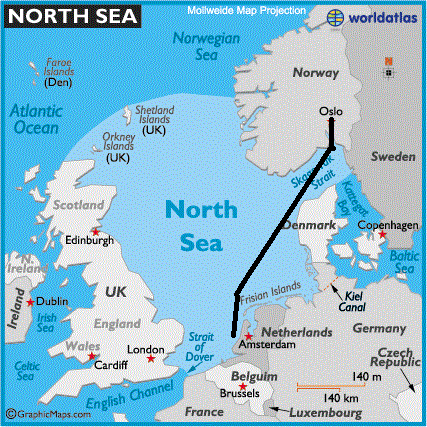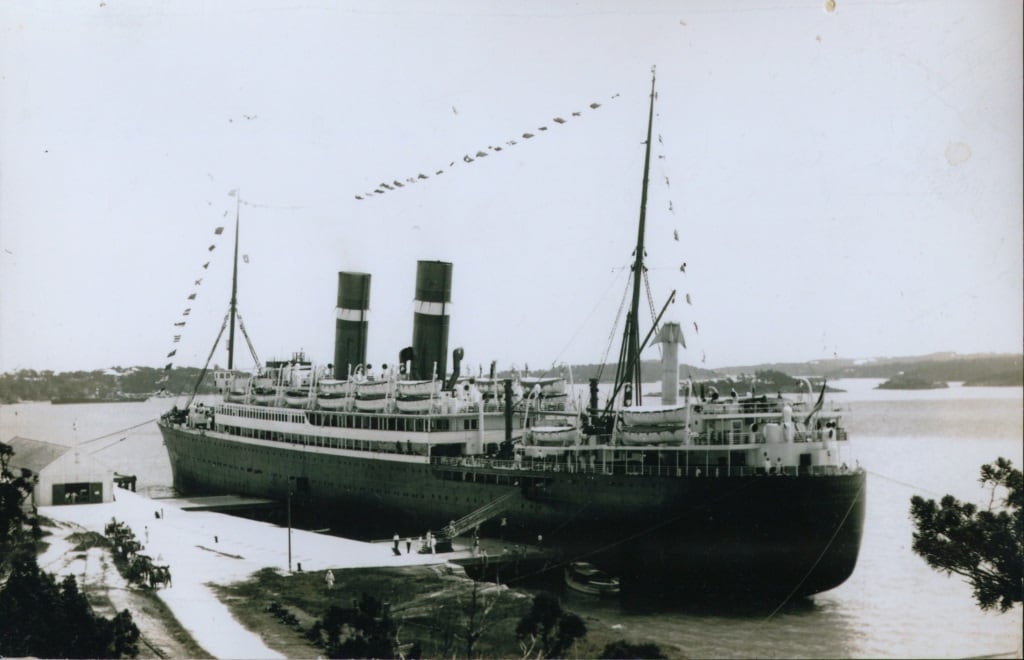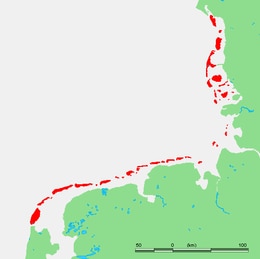Today we have our final day of the cruise and are on our way back to Amsterdam. As we are still in the middle of this high pressure system, the weather stays unabatedly beautiful and the only thing I can say is that we moved from a Norwegian heatwave into a Danish heatwave as most of the day we were sailing in an area which is called the Skagerrak. This is still the North Sea but the piece along the Danish coast up to the Norwegian coast. There it becomes the Kattegat where the North Sea connects with the Baltic. It is a bit of a question where the Skagerrak exactly ends and the North Sea begins. Scandinavians are quite focused on using the name Skagerrak; sailors seem to keep calling it North Sea until their ship sails over the letters in the chart that gives it the other name.

Our route from Oslo to Amsterdam. The water remains the same, the names change. (Thank you World Atlas via Wikipedia)
Whatever the preference, it is all the same water, water that comes from the North Atlantic Ocean flowing in north of Scotland or from the south through the Straits of Dover which the French call La Manche. The Dutch have adopted the English name: Straat van Dover while the Germans have gone for the French version: “Armel Kanal: which in both languages means sleeve or bent arm. And the bend in Dover Strait resembles something as a bent arm. The Dutch being the inventors of double Dutch have of course a second name for the strait: Het Nauw van Calais or the Calais Narrows, which makes sense as well as Calais is right on the edge of the narrowest part. Hence the fact that most ferries are sailing from Dover to Calais and back and also the Chunnel has its submerged pipes right here. So things are not so simple with the names in this area and the Skagerrak name is just one of them.
Unfortunately it is us the Dutch again who are also responsible for this name. Rak, in old Dutch means a straight Strait (so not a bent strait one as Dover Strait is) and thus we are speaking over here about the Strait of Skagen; the town on the east side of Denmark where the Skagerrak becomes the Kattegat. To make things worse the Dutch are also responsible for the name Kattegat. Kat = Cat and Gat = hole. The meaning is that this thoroughfare is a hole so tight that only a cat can get through. All these names are from the 17th. Century when the Dutch were the most powerful nation in the world and had the biggest fleet, produced the best charts which were then bought and used by the rest of the world. And so the names stuck.

The ss Veendam (II) docked at what we think is Bermuda. Please note the wind catcher above the aft lifeboats. This was the only form of A.C the ships had in those days. Going on a cruise was not for the faint hearted. The ships also went to Norway so they might have also experienced a “Norwegian Heatwave”.
Until well into the 19th. Century the Dutch dominated the trade to the Baltic and Russia and Holland America has its own connection with this, with the town of Veendam in the North of the Netherlands. Our current Veendam is the 4th. ship which carried this name. Veendam was such an important town of ships registry that Lloyds Register (and Lloyd’s insurance) opened up their first foreign office here in this town in Holland.

All the islands in the North Sea protecting the Frisian Hinterland since times immemorial. (Unknown Source on the Internet)
When sailing further down we come to the Frisian Islands. Also here enough room for confusion. As we have the west Frisian Islands (Dutch), the east Frisian Islands (German) and the north Frisian Islands (Danish). The Frisians are an ancient tribe, with their own language, who in the course of history got divided over what are now The Netherlands, Germany and to some extent Denmark. Thus the islands are split up as well between the three Nations. Normally when one speaks about the Frisian Islands the focus is on The East and West ones. The biggest ones belong to the Netherlands: Texel, Ameland, Terschelling, Vlieland, Schermonnikoog and then there are 9 more which are uninhabited. The Germans have more of them but on average smaller: Borkum, Juist, Norderney, Baltrum, Langeoog, Spiekeroog, Wangerooge, Neuwerk, Pellworn, Nordstrand (but now connected to the mainland) Halligen, Amrum, Fohr and Sylt. And they have 17 un-habited islands. On top of that the Germans have the island of Helgoland which is not part of the series but does belong. In the same way as Barbados is outside the Caribbean island ring but still considered to be part of the Caribbean. Then these Frisian Islands are part of a chain which runs from Texel all the way up to the Kattegat and those we call altogether the “Wadden Islands”.
So far the geography we are sailing past today. During the night we will come straight down the coast and then very early tomorrow morning we will be sailing into the North Sea Canal. In Amsterdam we will be docking Nose in, Starboard side alongside because we have a propeller / Azipod inspection. Last cruise we went portside, so they inspected the starboard pod and this time it will be the portside pod.
Weather, no change from expected. Warm but not so warm as in Norway. 28oC or 82oF.

July 29, 2018 at 3:59 am
Dear Captain, it is with much anticipation that I search my e-mail to find your blog articles daily.
So different compared to many others because while reading we share the insights into the day-by-day activities and facts, from another angle, that make our cruises safe and so well organized -the Holland America Line typical way.
For people alike me, who are cruising not in the first place for the daily parties and endless “food parades”, not for the overnight stays aboard in between two beaches and nor for the climbing walls and “Park Promenades at Sea”, but for the enjoyment of days at sea with interest about the geography and all facts worth knowing, the subjects you describe are nothing less than highly fascinating !
Thank you, sincerely.
Werner Verbrugge – Koksijde, Belgium.
July 29, 2018 at 9:32 am
Thank you for reading blog and for your kind words.
I will continue to do my best to keep it interesting and maybe also entertaining.
Best regards
Capt. Albert